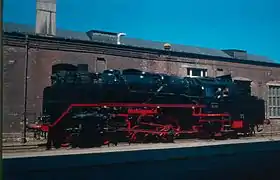DRG Class 62
The Class 62 engines were standard (see Einheitsdampflokomotiven) passenger train tank locomotives of Germany's Deutsche Reichsbahn-Gesellschaft (DRG).
| DRG Class 62 | |
|---|---|
 62 015 at Bw Chemnitz-Hilbersdorf station | |
| Number(s) | 62 001–015 |
| Quantity | 15 |
| Manufacturer | Henschel |
| Year(s) of manufacture | 1928–1932 |
| Retired | 1973 |
| Wheel arrangement | 4-6-4T |
| Axle arrangement | 2'C2' h2t |
| Type | Pt 37.20 |
| Track gauge | 1,435 mm (4 ft 8 1⁄2 in) |
| Length over buffers | 17,140 mm (56 ft 3 in) |
| Service weight | 123.6 t (121.6 long tons; 136.2 short tons) |
| Adhesive weight | 60.8 t (59.8 long tons; 67.0 short tons) |
| Axle load | 20.3 t (20.0 long tons; 22.4 short tons) |
| Top speed | both ways 100 km/h (62 mph) |
| Indicated Power | 1,236 kW (1,658 hp) |
| Driving wheel diameter | 1,750 mm (68.90 in) |
| Leading wheel diameter | 850 mm (33.46 in) |
| Trailing wheel diameter | 850 mm (33.46 in) |
| Valve gear | outside Walschaerts valve gear (Heusinger) with Kuhn slide |
| No. of cylinders | 2 |
| Cylinder bore | 660 mm (25.98 in) |
| Piston stroke | 600 mm (23.62 in) |
| Boiler Overpressure | 14 bar (1,400 kPa; 200 psi) |
| Grate area | 3.55 m2 (38.2 sq ft) |
| Superheater area | 72.50 m2 (780.4 sq ft) |
| Evaporative heating area | 195.95 m2 (2,109.2 sq ft) |
| Water capacity | 14 m3 (490 cu ft) |
| Fuel | 4.3 t (4.2 long tons; 4.7 short tons) coal |
| Auxiliary brake | Yes |
| Locomotive brakes | Knorr automatic, single-chamber, compressed-air brakes, working on front of coupled wheels and on inside of carrying wheels + counterweight brake |
| Train heating | Steam |
The Class 62s were developed and delivered by the firm of Henschel for the Reichsbahn during the 1920s. The engines were two-cylinder superheated steam locomotives. Fifteen units were manufactured. Although the engines were built as early as 1928, the Deutsche Reichsbahn did not take over numbers 62 003–015 until 1932. This was due to the low priority for such engines in the Reichsbahn, as well as the high cost. During the 1930s they were stationed at the locomotive depots (Bahnbetriebswerke or Bw) of Düsseldorf marshalling yard, Sassnitz on the island of Rügen and Meiningen. After the Second World War eight examples were left in the hands of the DR in East Germany and seven with the Deutsche Bundesbahn.
Up to 1967, engines in GDR were distributed around various depots including, for example, Meiningen, Berlin Ostbahnhof and Rostock. The engines also spent a short while in Wittenberge and Berlin-Lichtenberg depots. Number 62 007 was stationed from 8 April to 6 May 1967 in Schwerin, but was only stored there. In 1968 they were assembled at Frankfurt (Oder) shed. There the engines hauled trains on the Frankfurt (Oder)-Erkner route. At the beginning of 1970 only numbers 62 007, 62 014 and 62 015 were still in operation, in the Est Wriezen where they headed trains to Berlin-Lichtenberg. Number 62 007 was retired there in 1972, the last engine in schedule services, but continued to be used as a heating engine until 1973. The only surviving locomotive, no. 62 015, is today owned by the DB (Nuremberg Transport Museum) and is housed in the locomotive shed of the former Dresden-Altstadt depot. Until 1997 the engines was used to haul for special trains.
Immediately after the war, after they had been sent to Wuppertal, the Deutsche Bundesbahn housed its vehicles at Dortmund, Düsseldorf, Essen, and Krefeld. By 1956 the DB's Class 62s had been taken out of service. The last engine, 62 003, was retired in 1968 in Schwerte, after it had served as an instructional model from 1956 to 1966 in the engine driver school in Troisdorf.
Literature
- Endisch, Dirk (2002). Baureihe 62. Stuttgart: Transpress Verlag. ISBN 3-613-71199-0.
- Alfred B. Gottwaldt, ed. (1982), "Bilder aus der Geschichte der Baureihe 62", Lok-Magazin (in German), Stuttgart: Franckh’sche Verlagshandlung, W. Keller & Co. (116), pp. 362–368, ISSN 0458-1822
- Dirk Endisch: Baureihe 62. Transpress Verlag, Stuttgart 2002. ISBN 3-613-71199-0
- Thomas Frister; Hansjürgen Wenzel (ed.): Lokporträt Baureihe 62 Eisenbahn-Bildarchiv – Vol. 41. EK-Verlag, Freiburg 2009, ISBN 978-3-88255-380-2
- Oliver Strüber (2019), Rudolf Heym (ed.), "Die Außergewöhnliche Baureihe 62 im Porträt", Lok-Magazin (in German), Munich: GeraMond Verlag (1/2020), pp. 92–103, ISSN 0458-1822